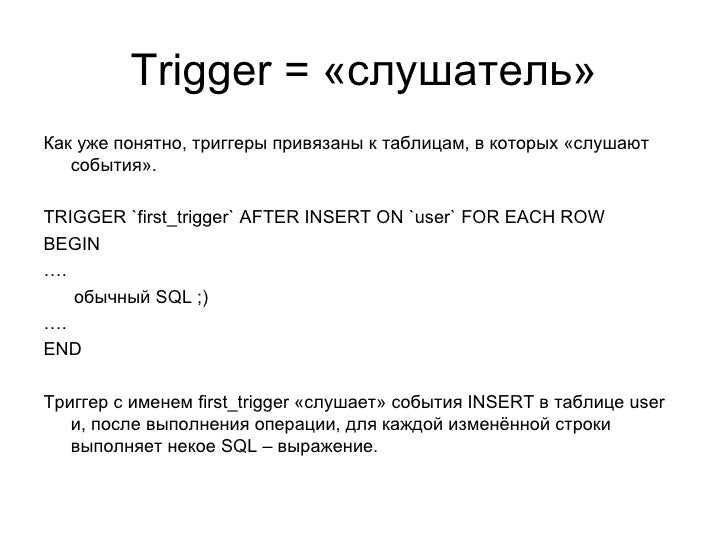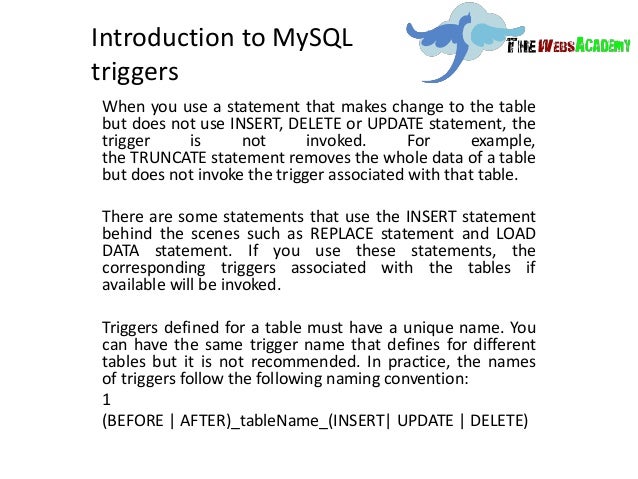Update On Trigger After Insert Mysql
A trigger is a program that may run automatically when a database operation is performed on a specified physical file (TABLE). The change operation can be an insert.
MySQL UPDATE Stored Procedure example. Source code to create and add sql update stored procedure to catalog. The following example is for creating a simple update. This Oracle tutorial explains how to create a BEFORE INSERT Trigger in Oracle with syntax and examples. A BEFORE INSERT Trigger means that Oracle will fire this. MySQL trigger is a named database object which is associated with a table, and it activates when a particular event (e.g. I am trying to create a trigger each time after data is inserted, updated or deleted. The trigger for inserting is working fine but i am having some issues with the. Here we will see how to create an insert, update and delete application in MVC 4 using Razor.
My. SQL - SQL INSERT Stored Procedure. Source code to create and add . You can run it through an explicit call from a host language program. You. must however populate all columnar data associated with the PK (primary. I have included a cross section of columns for your reference.
This is MySQL PHP tutorial. Disco De Instalacion De Impresora Canon Ip2700 Cable Usb. In this tutorial, you will learn the basics of database programming in MySQL and PHP language. A trigger is a special type of stored procedure that is executed when an INSERT, DELETE or UPDATE statement modifies data in a table. SQL Server initiates an AFTER.

SQL INSERT. Datetime and. Integer data is. entered without quotes. I also included all columns that were. NOT NULL. I also included the password column which is part. You will note that I did not include columns for some.
Having said this, in the . I just wanted to make a technical point here. The. pragmatic point is that you would want to expose columns that are part. What stored row looks like after the SQL INSERTI want to call you attention to the fact that all columns that are. Also, if the schema had.
RPGLE Trigger program example - Insert, Update, Delete and Read events. A trigger is a program that may run automatically when a database operation is performed on a specified physical file (TABLE). The change operation can be an insert, update, or delete high level language statement in an application program, or an SQL INSERT, UPDATE, or DELETE statement. Triggers are useful for tasks such as enforcing business rules, validating input data, and keeping an audit trail.
When a trigger is added to a database file, the database operation passes two parameters to a trigger program, which you must capture .. The trigger buffer, which contains information about the database operation and before/after images of the database file. The length of the trigger buffer. RPGLE Trigger Program example source code *. TRIGGER BUFFER data structure. Standard data type definitions.
Buffer length and pointers to before & after images. Status Data Structure. Bf). d based(tgbfrptr).
Af). d based(tgaftptr). In case of UPDATE you will have both Before and After images, so you can compare the fields for any changes in data. For INSERT you only have the after image and for DELETE you have the before image. In the above example before and after images are mapped to external data structures based on the file to which the trigger will be attached.
Also we have configured different prefix to both the data structures so the field names will be different. Say the physical file has a field named FLD1 then the before image in the trigger program will be in field named BFFLD1 and the after image in field named AFFLD1. Adding a trigger to a file. Use i. Series. On the Table Properties dialog, click the Triggers tab. Select Add system trigger to add a system trigger. Select Add SQL trigger to add an SQL trigger Use the Add Physical File Trigger (ADDPFTRG) command. The Add Physical File Trigger (ADDPFTRG) command adds a system trigger to a specified physical file.
The Remove Physical File Trigger (RMVPFTRG) command removes the triggers that call trigger programs from a specified physical file. In this way, users who do not have the same level of authority to the program will not encounter errors. Create the program with USRPRF(*OWNER) and *EXCLUDE public authority, and do not grant authorities to the trigger program to USER(*PUBLIC). Avoid having the trigger program altered or replaced by other users. The database invokes the trigger program whether or not the user causing the trigger program to run has authority to the trigger program. Create the program as ACTGRP(*CALLER) if the program is running in an ILE environment.
This allows the trigger program to run under the same commitment definition as the application. Open the file with a commit lock level the same as the application's commit lock level. This allows the trigger program to run under the same commit lock level as the application. Create the program in the physical file's library. Use commit or rollback in the trigger program if the trigger program runs under a different activation group than the application. Signal an exception if an error occurs or is detected in the trigger program.
If an error message is not signalled from the trigger program, the database assumes that the trigger ran successfully. This may cause the user data to end up in an inconsistent state.
